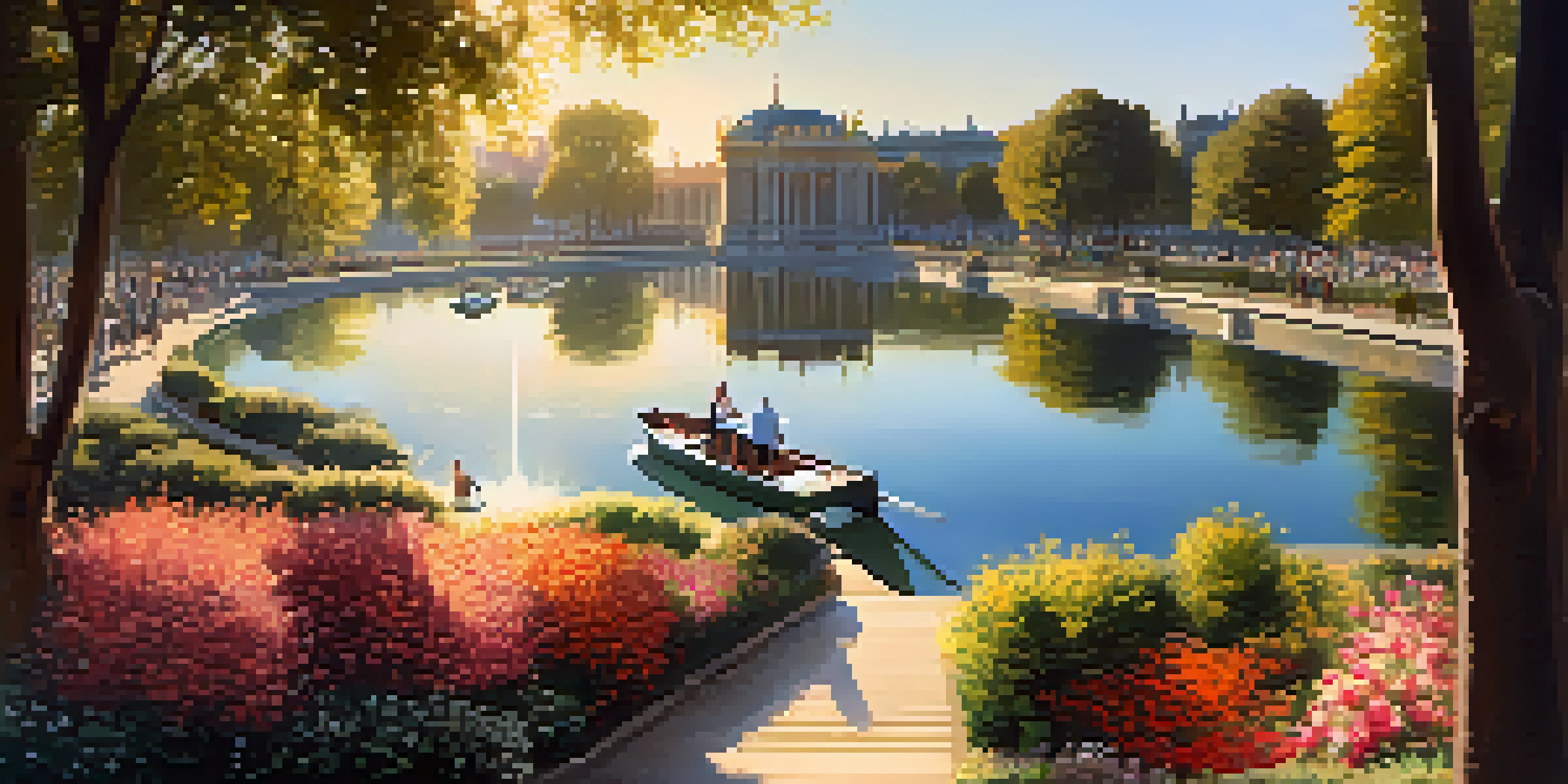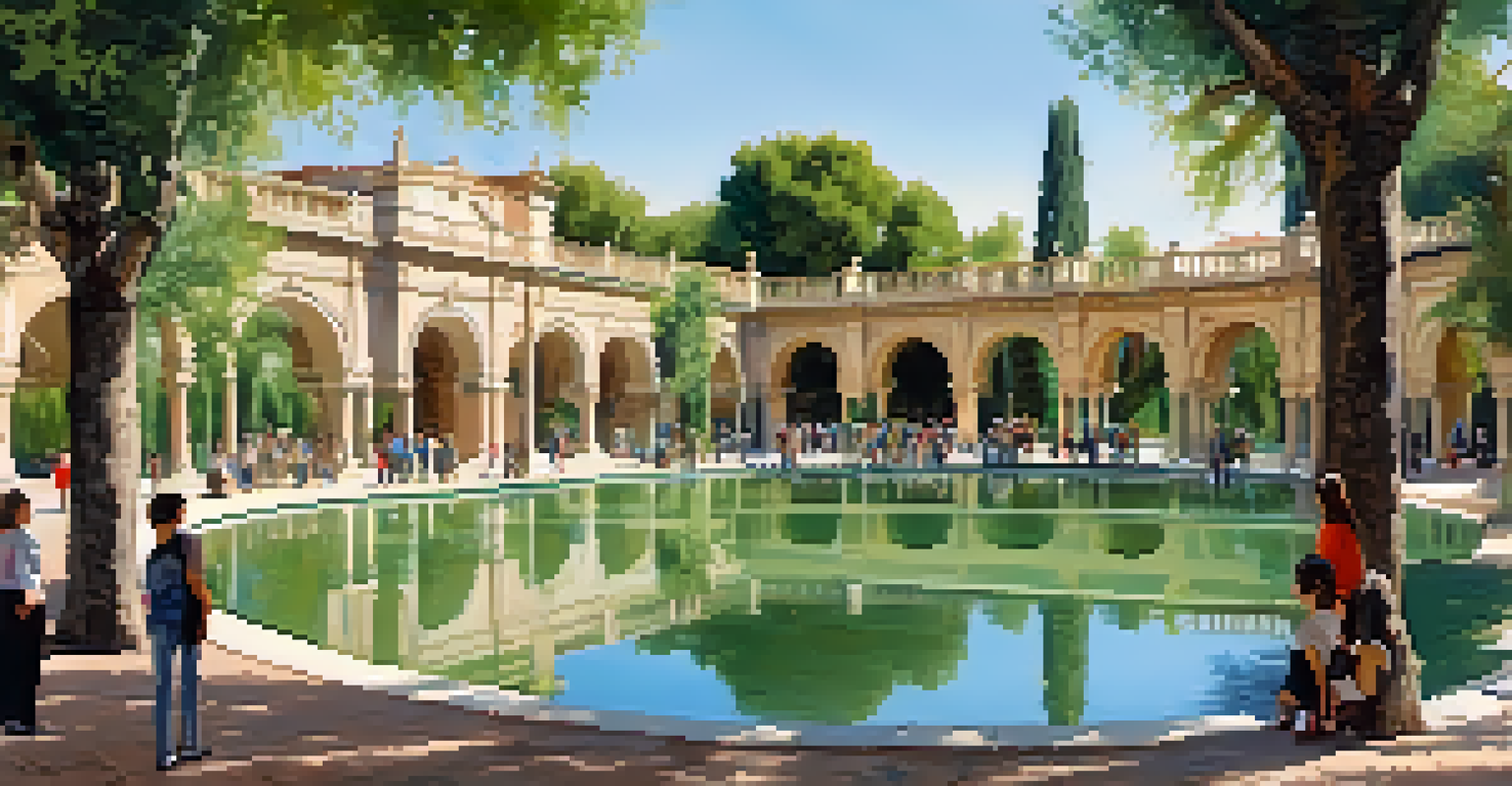The Role of Historical Parks in Urban Spanish Life

Historical Parks: A Glimpse into Spain's Rich Heritage
Historical parks in Spain serve as living museums, showcasing the country's diverse cultural heritage. These green spaces often house monuments, sculptures, and gardens that tell stories of Spain's past. Visitors can stroll through these parks, absorbing the ambiance and learning about significant events that shaped the nation.
Parks are not only the lungs of the city, but also the heart and soul of the community.
For instance, the Retiro Park in Madrid not only provides a peaceful retreat but also features historical landmarks like the Crystal Palace and the historic boating lake. Such sites invite locals and tourists alike to immerse themselves in the historical narrative of the city. This blend of leisure and education makes historical parks vital to urban life.
Moreover, these parks often host cultural events, exhibitions, and festivals that celebrate local traditions. By engaging the community and preserving history, these spaces foster a sense of belonging and pride among residents.
A Breath of Fresh Air: Parks in Urban Environments
In bustling cities, historical parks offer a much-needed escape from the hustle and bustle of urban life. They provide a serene environment where people can relax, exercise, and connect with nature. This is especially important in Spanish cities, where vibrant street life can sometimes feel overwhelming.

Take, for example, the Parque de la Ciudadela in Barcelona, which serves as a green oasis amidst the city's fast pace. Here, residents can enjoy picnics, jog along tree-lined paths, or simply unwind by the lake. This balance between urban intensity and natural tranquility is crucial for mental well-being.
Historical Parks as Cultural Hubs
Historical parks in Spain serve as vital community spaces that host cultural events, fostering a sense of identity and belonging among residents.
Access to green spaces has been linked to improved physical health and social cohesion. Historical parks encourage community gatherings, fostering friendships and connections among diverse groups.
Cultural Significance: Historical Parks as Community Hubs
Historical parks often act as cultural hubs, bringing together diverse communities through shared experiences. These spaces frequently host cultural events, such as concerts, art exhibitions, and traditional festivals that reflect the local culture. For many, these gatherings are a cherished part of their community identity.
Nature is not a place to visit. It is home.
In Seville, for instance, the Parque de María Luisa is known for its annual Feria de Abril, where locals celebrate with music, dance, and vibrant displays of traditional costumes. Such events draw crowds from all walks of life, strengthening community bonds. It's a place where history, culture, and modern life intertwine beautifully.
Additionally, these parks can act as a canvas for local artists, who often showcase their work in these settings. This not only enriches the cultural landscape but also gives artists a platform to connect with the community.
Educational Opportunities: Learning in Green Spaces
Historical parks are not just for relaxation; they are also valuable educational resources. Many parks offer guided tours, workshops, and informational signage that educate visitors about their historical significance. This makes them essential for fostering a deeper understanding of Spain's rich history and culture.
For example, in Valencia, the Turia Gardens incorporate educational elements about the region's historical irrigation systems. Visitors can explore the evolution of urban planning and environmental management in a hands-on manner. Such interactive experiences make learning engaging and memorable.
Parks Enhance Urban Well-being
These green spaces provide essential escapes from city life, promoting mental well-being and physical health through relaxation and social interaction.
Moreover, schools often organize field trips to these parks, allowing students to connect classroom lessons with real-world history. This experiential learning approach encourages curiosity and appreciation for one’s heritage.
Preservation of Nature: Balancing History and Ecology
The preservation of historical parks is crucial not only for cultural heritage but also for environmental sustainability. These parks often serve as habitats for various species and play a significant role in urban biodiversity. Maintaining these green spaces is essential for promoting ecological balance within cities.
In Madrid, the Casa de Campo is a prime example of a historical park that provides refuge for wildlife while offering recreational opportunities for residents. Efforts to conserve these areas ensure that future generations can enjoy both their historical and environmental benefits.
Additionally, these parks contribute to better air quality and climate regulation in urban areas. As cities continue to grow, integrating natural spaces into urban planning becomes increasingly important.
Tourism Boost: Historical Parks as Tourist Attractions
Historical parks are major attractions for tourists, drawing visitors eager to experience Spain's unique cultural landscape. Travelers often seek out these parks not only for their beauty but also for the rich history they represent. This influx of visitors can significantly benefit local economies.
For instance, the Alcázar Gardens in Seville attract thousands of tourists every year, boosting nearby businesses such as cafes, shops, and hotels. This symbiotic relationship highlights the importance of preserving these spaces for both cultural and economic reasons.
Tourism Boost from Historical Parks
Attracting tourists with their beauty and history, historical parks contribute significantly to local economies while enriching visitor experiences.
Moreover, historical parks often serve as gateways to exploring the surrounding neighborhoods, further enriching the tourist experience. Visitors can immerse themselves in local culture while enjoying the natural beauty of these historic sites.
The Future of Historical Parks in Urban Spain
As urbanization continues to rise, the future of historical parks in Spain faces both challenges and opportunities. Balancing development with the preservation of these green spaces is vital for maintaining the cultural fabric of cities. Community involvement and sustainable practices will play a crucial role in this endeavor.
Efforts are already underway in many cities to revitalize and maintain historical parks, ensuring they remain accessible and relevant. By engaging local communities in conservation efforts, cities can foster a sense of ownership and pride in these spaces.

Looking ahead, the integration of technology and innovative design can further enhance the role of historical parks in urban life. Embracing these changes while honoring the past will ensure that these parks continue to thrive for generations to come.